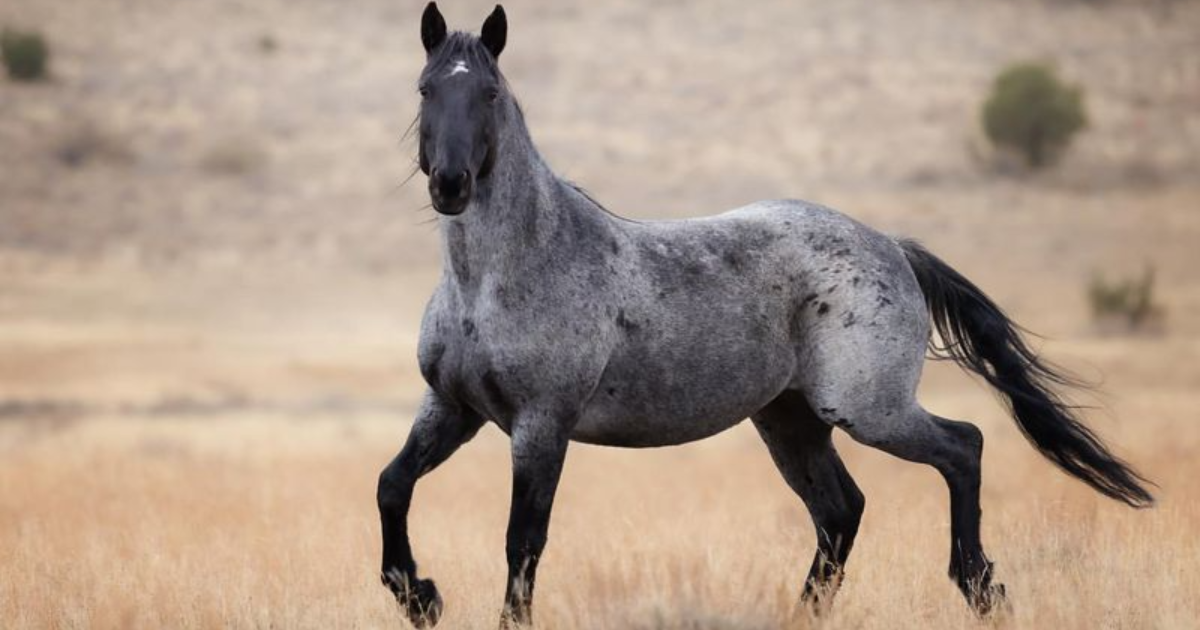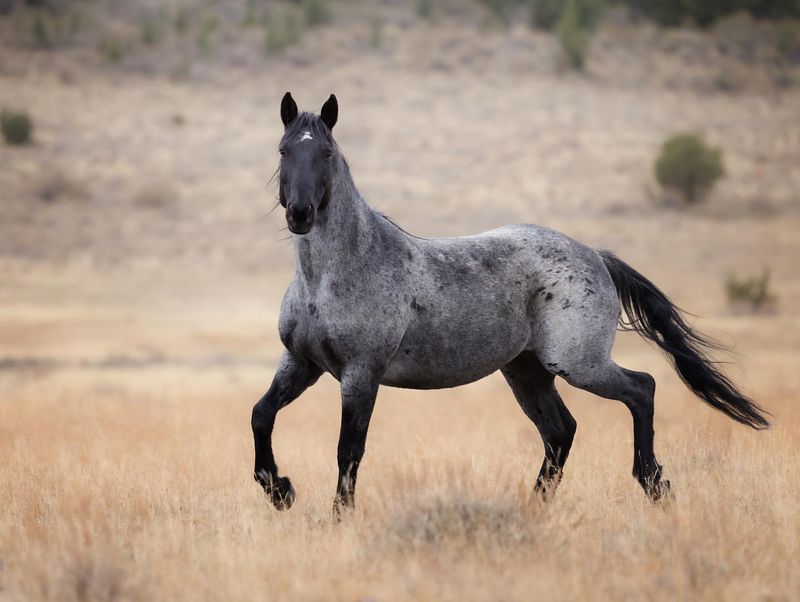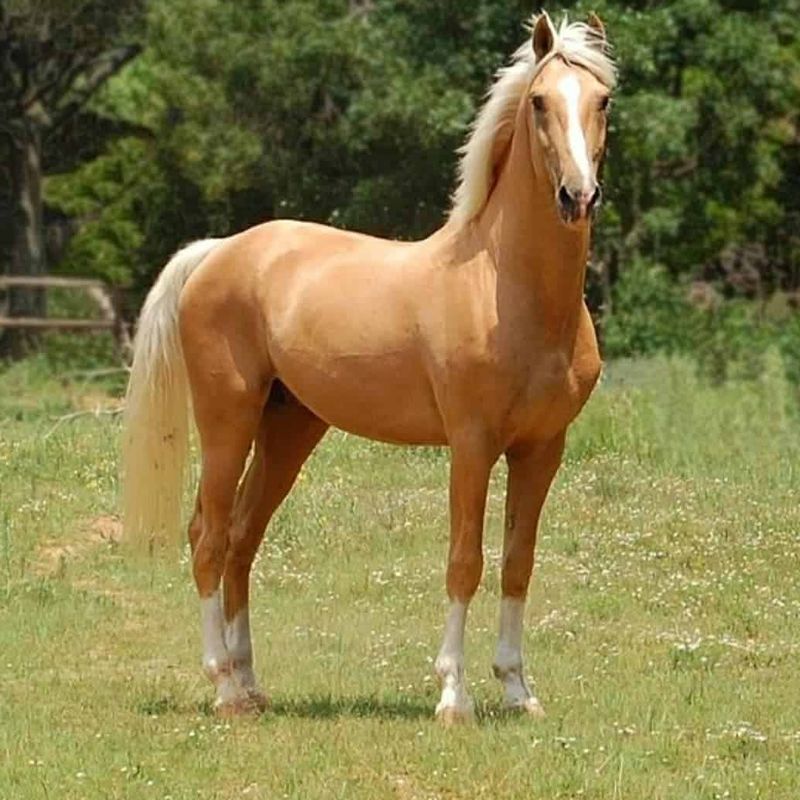📖 Table of Content:
Exploring the vibrant and diverse spectrum of horse coat colors offers a fascinating glimpse into the genetics and history of these majestic creatures.
From the rarest hues that appear almost mystical to the more common shades that grace fields and stables worldwide, each color tells a unique story.
Understanding these shades not only enhances our appreciation of horses but also aids in identifying breeds and lineages, as certain colors are tied to specific genetic traits. This comprehensive guide will take you through a captivating journey from the rarest to the most common horse colors.
1. Perlino
Perlino horses, known for their creamy coats and mesmerizing blue eyes, are a rare sight in the equine world. This color arises from a bay base coat, altered by two cream genes. The result is a pale, almost beige or ivory appearance unique to this genetic combination. Perlino coat colors are not just visually appealing but also indicate a specific lineage often linked to certain breeds.
The rarity of this color can be attributed to the specific genetic requirements needed for its manifestation. These horses typically require both parents to carry the cream gene, making it a less common occurrence. Enthusiasts often seek them for their distinctive look and the genetic rarity adds to their appeal.
Despite their rarity, perlino horses are as capable and versatile as any other, excelling in various disciplines. Their unique appearance often makes them standouts in shows and competitions.
2. Cremello
Cremello horses boast a luxurious cream-colored coat combined with striking blue eyes, creating a captivating and rare appearance. This enchanting color results from a chestnut base coat, modified by two cream genes, giving the horse its distinct, light hue.
Due to the genetic requirements for breeding cremello horses, they are relatively uncommon. Both parents must carry the cream gene for this coat color to manifest, highlighting the intricate genetic dance involved. These horses are often prized for their unusual appearance and are frequently sought after by breeders and enthusiasts alike.
Despite their rarity, cremellos have the same capabilities and strengths as other horses and are often seen excelling in various equestrian disciplines. Their standout appearance makes them popular choices in horse shows and competitions.
3. Grullo
Grullo horses, adorned with their smoky gray coats and distinct black points, are a rare and stunning sight. This unique coloration comes from a black base coat influenced by the dun gene, producing the grullo’s characteristic gray tone.
Often considered one of the rarest dun variations, grullo horses are highly valued for their distinctive appearance. The coat’s smoky hues, coupled with black mane, tail, and lower legs, make them stand out among equines. A dorsal stripe running along their back further accentuates their unique look.
Though rare, grullos are not just prized for their beauty. They are hardy and versatile, known for their strength and agility. Enthusiasts often seek them for their rarity and the allure of owning such a uniquely colored horse.
4. Blue Roan
Blue roan horses present a captivating blend of black and white hairs, creating an overall blue-gray appearance. This striking color pattern is not just eye-catching but also quite rare, making blue roans highly sought after in the equine world.
The roan gene, which affects the distribution of colors, results in a unique variegated coat that changes subtly with the seasons. Blue roans often have darker heads and legs, adding to their distinctive look. This color can appear in various horse breeds, contributing to its fascinating diversity.
Blue roans are cherished not only for their beauty but also for their robust nature. They are often seen excelling in various disciplines, from show jumping to trail riding, showcasing their versatility and strength alongside their remarkable appearance.
5. Buckskin
Buckskin horses are admired for their golden coats and contrasting black manes and tails, a combination that exudes natural elegance. This color results from a bay base coat influenced by a single cream gene, creating a warm, golden hue.
While not as rare as some other colors, buckskins are still considered unique and are highly valued for their beauty. The black points on their legs, manes, and tails add a dramatic flair to their overall appearance. This coloration can be found in various breeds, making it a versatile and appealing choice for many.
Buckskins are known for their versatility and strong work ethic. They excel in many equestrian disciplines, from Western riding to dressage, and their striking appearance often makes them favorites in competitions and shows.
6. Palomino
Palomino horses, with their dazzling golden coats and contrasting white manes and tails, embody elegance and charm. This captivating color results from a chestnut base coat modified by a single cream gene.
While palominos are not exceedingly rare, they hold a special place in the hearts of equine enthusiasts. Their stunning appearance is often associated with beauty and grace, making them popular in show rings and competitions. The golden coat, combined with a silky white mane and tail, creates a striking visual contrast.
Palominos are versatile and perform well in various equestrian events. Their eye-catching looks and friendly dispositions make them favorites not only among riders but also in popular media, where they often represent the quintessential “perfect” horse.
7. Bay
Bay horses are renowned for their rich brown coats and contrasting black manes, tails, and legs, exuding a classic and timeless beauty. This common color arises from a genetic base of agouti on a black coat, creating the characteristic bay hue.
Despite their prevalence, bay horses are celebrated for their versatility and are found in numerous horse breeds across the globe. Their striking appearance and balanced coloration make them favorites in a variety of equestrian disciplines, from racing to jumping.
Bay horses are not just visually appealing but also embody strength and agility. Their commonality does not detract from their value, as their classic appearance and robust nature make them a steadfast choice for riders and breeders alike.
8. Chestnut
Chestnut horses, with their vibrant reddish-brown coats, are a common yet beloved sight in the equine world. This color is the result of a recessive genetic trait that is widely distributed across many horse breeds.
The chestnut color can vary in shade, from a deep, rich auburn to a light, coppery hue, offering a beautiful spectrum of possibilities. Despite its commonality, the chestnut coat’s warm tones and natural shine make it stand out, especially when groomed to perfection.
Chestnut horses are known for their friendly and spirited nature. Their widespread presence in various breeds underscores their adaptability and strength. Whether in a show ring or on a trail, chestnuts bring both beauty and performance to the fore.
9. Black
Black horses, with their sleek, glossy coats, exude an aura of mystery and elegance. This coat color, although common, is often associated with power and beauty in the equine domain.
Genetically, black is one of the base colors in horses, resulting from a dominant gene. This color is found in many breeds, contributing to its widespread presence. Despite its commonality, a well-groomed black coat remains a striking and commanding sight, especially in competitive arenas.
Black horses are celebrated for their strength and versatility. Whether in dressage, racing, or as symbols of majesty in cultural representations, they never fail to capture attention. Their classic appearance and dynamic presence ensure they remain popular across various equestrian disciplines.









